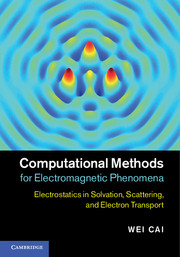 Computational Methods for Electromagnetic Phenomena
Computational Methods for Electromagnetic Phenomena Book contents
- Frontmatter
- Contents
- Foreword
- Preface
- Part I Electrostatics in solvation
- 1 Dielectric constant and fluctuation formulae for molecular dynamics
- 2 Poisson–Boltzmann electrostatics and analytical approximations
- 3 Numerical methods for Poisson–Boltzmann equations
- 4 Fast algorithms for long-range interactions
- Part II Electromagnetic scattering
- Part III Electron transport
- References
- Index
2 - Poisson–Boltzmann electrostatics and analytical approximations
from Part I - Electrostatics in solvation
Published online by Cambridge University Press: 05 February 2013
- Frontmatter
- Contents
- Foreword
- Preface
- Part I Electrostatics in solvation
- 1 Dielectric constant and fluctuation formulae for molecular dynamics
- 2 Poisson–Boltzmann electrostatics and analytical approximations
- 3 Numerical methods for Poisson–Boltzmann equations
- 4 Fast algorithms for long-range interactions
- Part II Electromagnetic scattering
- Part III Electron transport
- References
- Index
Summary
In this chapter, firstly we introduce the Poisson–Boltzmann (PB) equation, based on the Debye–Hückel potential of mean force (PMF) approximation for electrostatic interactions for biomolecules in ionic solvent, and then secondly we introduce the concept of electrostatic solvation energy. Several analytical approximation methods for solving electrostatic solvation problems will be discussed. First, the generalized Born approximation is described for the electrostatic solvation energy using Born radii for atoms embedded in molecules. A fast Fourier transform (FFT)-based algorithm for calculating the Born radii is given. Then we present various image approximations to electrostatic reaction fields in the Poisson and Poisson-Boltzmann electrostatic models in the presence of dielectric or perfectly conducting materials with boundaries such as single or multiple planes, with spherical and cylindrical geometries.
Poisson–Boltzmann (PB) model for electrostatic solvation
The electrostatic force is one of the most important forces in ion–ion, ion–solvent, and solute molecule–solvent interactions (Milner, 1912; Bockris, Reddy, & Gamboa-Aldeco, 2000) for understanding the structure and stability of biomolecules in an aqueous environment. Such interactions are defined as a solvation process of ions or solutes by solvent molecules such as the formation of the hydration shells around ions by water molecules. The classical electrostatic theory can be applied to the system comprising the solute macromolecule and the surrounding ionic solvent environment (Honig & Nicholls, 1995; Fogolari, Brigo, & Molinari, 2002).
- Type
- Chapter
- Information
- Computational Methods for Electromagnetic PhenomenaElectrostatics in Solvation, Scattering, and Electron Transport, pp. 26 - 59Publisher: Cambridge University PressPrint publication year: 2013


